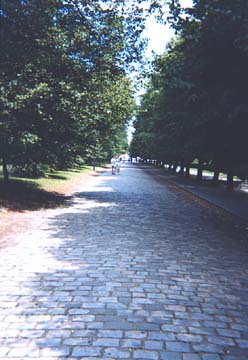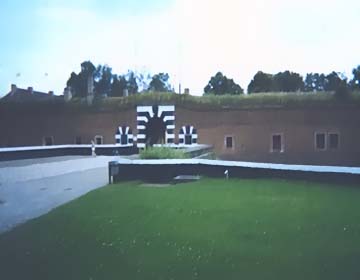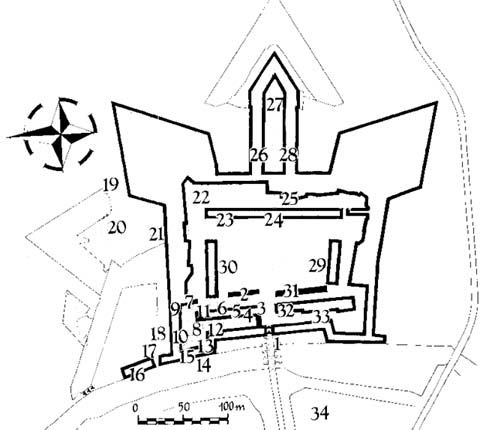-
Entrance
Gate
-
Administration
Court
-
Reception Office : Prisoners records were
kept here by the deputy prison commander W Schmidt who after WWII was
sentenced & executed.
-
Guards
Office : Inmates were interrogated and their mail was
censored here
-
Prison
commanders office : The post was held by Heinrich Jöckel
for the duration of the war he was a man noted for his cruelty and was
sentenced & executed in 1946
-
Clothes
store : This was managed by K. Wachholz
who dressed the prisoners in discarded uniforms of defeated soldiers. K
Wachholz was sentenced to death in what was East Germany in
1968
-
"Arbeit macht
frei" was
the inscription above this gate: A common inscription at most nazi camps
but not usually Gestapo prisons. This was the entrance to the first
court yard
-
First
Courtyard : This courtyard was in two parts Blocks 'A' &
'B' in them they contained 17 large cells and 20 solitary confinement
units. The courtyard was the home of some 1500 inmates
-
The
Cells : up to 100 prisoners were crowded in to each cell.
Cell no: 1 was for the Russian prisoners, cell nos: 2 & 3 were for
Jews who had been arrested for political activities & for violation
of anti-Jewish regulations.
-
The Surgery :
Was
the domain of the officially appointed police doctor B.Krönert of
Litoměřice
-
Commanders office (First Courtyard) : A
Neubauer & then S Rojko ran this office it was where records of the
prisoners in cells were kept and where working commandos were put
together
-
Solitary
Confinement : As the name implies prisoners were isolated
from others while they waited for their punishment or
execution
-
Bathroom
& Delousing room
-
Sick Room : Imprisoned
doctors attended the sick prisoners here
-
Shaving
Room : This was a so called "Show Shaving Room" designed to
show prison authorities how well sanitary conditions were for the
prisoners
-
Hospital
Block : towards and at the end of the war hundreds of
prisoners died here form typhoid fever in horrible conditions. during
1944 the women's section was temporarily moved here
-
Underground Passage : This was part of the
original fort but was not used during the war
- Mortuary
: The corpses of tortured prisoners were kept here. they were
burned in the crematorium from 1942
|


The Small
Fortress was built in the late 18th century near the Elbe And Ohře
rivers.
It was named
after the Empress.
Since
construction almost it has been used as a prison with various elements
from history being held here.
During World
War II the existing jails were gradually filled up due to the Nazi
terrors, so the Small Fortress became Prague's Gestapo prison during
1940.
The first
prisoners arrived on June 14th 1940. During the war some 32,000 prisoners
including 5,000 women went through the gates.
Originally it
was mainly Czech citizens, but as the war progressed other nationalities
began arriving.
There were
Soviets, Poles, Germans Yugoslavs & towards the end of the war POW's
from the British Army.
Terezín was
primarily a way station for the majority of prisoners who had been
arrested for various "crimes" of protest against the Nazi system. They
awaited shipment to concentration camps where some 8000
died.
In Terezín
itself 2500 prisoners died due to jail conditions, torture by guards and
disease.
The guards
finally abandoned the fortress on May 5th 1945.
Physicians and nurses from Prague and surrounding
towns moved in to stop the epidemic of typhoid that had broken out which
had gone uncared for by the guards.
With the
Soviet Army arriving on May 8th 1945 the epidemic
was
finally controlled with the help of the Soviet Medical
staff.
Terezín was
used as a detention camp between 1945 & 1948 for the Germans expelled
from Czechoslovakia

Monumental Tributes
HOME
|
-
Place of execution
: From
1943 prisoners were executed about 250 were shot, on may 2nd 1945 the
largest execution was carried out with some 52 inmates being killed. The
gallows were only used for hanging once for three prisoners
-
Mass graves :
In the summer of 1945 601 corpses were exhumed and reburied in
the national cemetery
-
Gate of Death
: Prisoners
had to pass through here on their way to execution
-
Swimming
pool : The pool was built in 1942 for the guards and their
families to swim in. It was constructed by students and Jewish prisoners
who were beaten and tortured while they worked
-
Cinema
: The cinema was established in 1942 for the use of the
guards
-
Fourth Courtyard
: The
construction of the fourth courtyard began in 1943 with the arrival of
the first prisoners in the autumn of 1944. by the end of the war nearly
3000 prisoners lived and nearly died here
-
Fourth
Courtyards Administration Building : Today it holds earth
from all the concentration camps the prisoners were sent to
-
Individual Mass
Cells : These
cells held 400-600 people, prisoners marked XYZ in cell no: 44 were
concentrated until execution#
-
Cells
in raised courtyard & warning gallows
: in
March 1945 three prisoners failed to escape from cell no:38, one of the
escapees two other men and a woman were selected at random and executed
in the courtyards corner as a warning to others. The remaining two were
caught and stoned to death near the solitary confinement blocks in the
first courtyard
-
Solitary
confinement blocks : These
were used as mass cells during 1945
-
SS-Barracks : 120 SS-guards lived in this
block
-
Lord's
House (so-called) : This was home to the Prison commander and
some of the guards and their families
-
Second
Courtyard : Contained in this courtyard were mostly workshops
where prisoners were made to work
-
Canteen
: The canteen was for the use of the prison staff
-
Third
Courtyard : The third courtyard was reserved for women from
1942, but in 1944 they were moved temporarily to the hospital so the
first working transport for the Litomĕřice concentration camp could be
housed here
-
National Cemetery
: The cemetery was gradually filled between 1942 &
1958, It now contains some 10,000 corpses from the small fortress,
Terezín ghetto and Litomĕřice concentration camp, 2386 corpses are
buried in individual graves.
|


